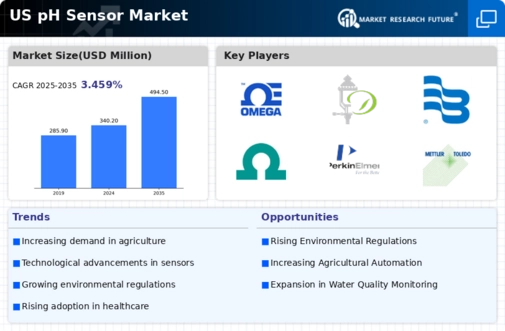Rising Demand in Agriculture
The ph sensor market is experiencing a notable surge in demand within the agricultural sector. Farmers increasingly recognize the importance of soil pH in determining crop yield and quality. As a result, the adoption of pH sensors for soil testing is on the rise, with the market projected to grow at a CAGR of approximately 7% over the next five years. This growth is driven by the need for precision agriculture, where pH sensors play a crucial role in optimizing fertilizer application and enhancing soil health. The integration of pH sensors into agricultural practices not only improves productivity but also promotes sustainable farming methods, thereby contributing to the overall growth of the pH sensor market.
Expansion of Industrial Applications
The pH sensor market is benefiting from the expansion of industrial applications across various sectors, including chemical manufacturing, food and beverage, and pharmaceuticals. As industries strive for greater efficiency and quality control, the demand for precise pH measurement is increasing. The market is projected to grow at a rate of 7% as industries recognize the critical role of pH sensors in process optimization and product quality assurance. The pH sensor market is thus positioned to capitalize on this trend, as more companies integrate pH monitoring into their operational processes to enhance productivity and compliance.
Water Quality Monitoring Initiatives
The pH sensor market is significantly influenced by increasing initiatives aimed at water quality monitoring. With growing concerns over water pollution and its impact on public health, regulatory bodies are mandating stringent water quality standards. This has led to a heightened demand for pH sensors in various applications, including municipal water treatment and industrial effluent monitoring. The market is expected to witness a growth rate of around 6% as organizations invest in advanced pH monitoring systems to ensure compliance with environmental regulations. The pH sensor market is thus positioned to benefit from these initiatives, as accurate pH measurement is essential for maintaining water quality and safety.
Technological Innovations in Sensor Design
Innovations in sensor technology are driving the evolution of the pH sensor market. Recent advancements in materials and design have led to the development of more accurate, durable, and cost-effective pH sensors. For instance, the introduction of solid-state sensors and miniaturized devices has expanded the application range of pH sensors across various industries, including pharmaceuticals and food processing. The market is projected to grow by approximately 8% as these technological advancements enhance the performance and reliability of pH sensors. The pH sensor market is thus benefiting from a shift towards more sophisticated and user-friendly sensor solutions, catering to diverse customer needs.
Increased Focus on Environmental Sustainability
The pH sensor market is witnessing a growing emphasis on environmental sustainability, which is shaping consumer preferences and regulatory frameworks. Industries are increasingly adopting pH sensors to monitor and manage their environmental impact, particularly in waste management and pollution control. This trend is likely to propel the market forward, with an anticipated growth rate of 5% as companies seek to comply with environmental regulations and improve their sustainability practices. The pH sensor market is thus becoming integral to efforts aimed at reducing ecological footprints and promoting responsible resource management.























Leave a Comment